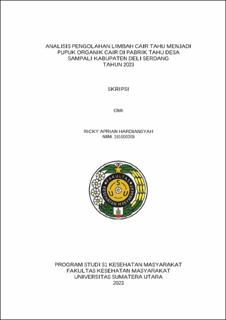Analisis Pengolahan Limbah Cair Tahu Menjadi Pupuk Organik Cair di Pabrik Tahu Desa Sampali Kabupaten Deli Serdang Tahun 2023

Date
2023Author
Hardiansyah, Ricky Aprian
Advisor(s)
Santi, Devi Nuraini
Metadata
Show full item recordAbstract
Tofu factories do not handle their liquid waste properly and directly discharge it into the water body just behind the factories. The estimated weekly amount of generated liquid waste is approximately 140 liters. The continuous disposal of waste into the water body negatively impact environmental quality. The objective of this study is to analyze the initial volume of tofu liquid waste before its conversion into liquid organic fertilizer (POC) and the subsequent reduction in the liquid waste volume after the conversion process, as well as the NPK content and pH of POC. A descriptive research was conducted to determine the levels of NPK and pH in POC derived from tofu liquid waste with the addition of local microorganism (MOL) from papaya waste and banana peel. The research was conducted at Saudara Kembar Factory in Sampali village, Deli Serdang. This research consisted of 3 types of treatments, such as untreated tofu liquid waste, papaya waste MOL addition, and banana peel MOL addition. Each treatment consisted of 5 liters of tofu liquid waste. The results indicated that untreated POC had N, P, K content of 0.0211%, 0.2110%, and 0.0410%, respectively, and pH level of 5.7. The addition of papaya waste MOL resulted in 0.0230% N content, 0.1668% P content, 0.0730% K content, and pH level of 6.5. Meanwhile, the addition of banana peel MOL resulted in 0.0212% N content, 0.1772% P content, 0.650% K content, and pH level of 6.2. Although the N, P, and K values did not meet the required standard, the pH level complied with Minister of Agriculture Regulation No 261 of 2019. Tofu factories can become the model of liquid waste processing by incorporating papaya waste and banana peel MOL to reduce tofu liquid waste volume.
Collections
- Undergraduate Theses [3186]
